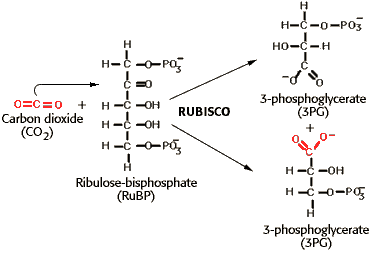
Photosynthesis Problem Set 2
Problem 4 Tutorial: Calvin cycle experiment.
Calvin and colleagues determined the pathway of carbohydrate synthesis in plants by studying the incorporation of radioactive carbon dioxide into biological compounds. Suppose that photosynthesis is proceeding at a steady pace in a typical experiment with the lights on, and carbon dioxide is being combined with ribulose-bisphosphate (RuBP) to produce 3-phosphoglycerate (3PG). Then suddenly the source of carbon dioxide is eliminated. What changes in the concentrations of 3PG and RuBP would occur?
Reactions of the Calvin-Benson cycle
The key steps of the reactions of the Calvin-Benson cycle, also known as the dark reactions of photosynthesis, are shown in the diagram.

Reaction catalyzed by RUBISCO
CO2 enters the cycle as a substrate for RUBISCO, the CO2-fixing enzyme of photosynthesis. The reaction catalyzed by RUBISCO is as follows:

University of Arizona
Thursday, October 3, 1996
Contact the Development Team
http://www.biology.arizona.edu
All contents copyright © 1996. All rights reserved.






